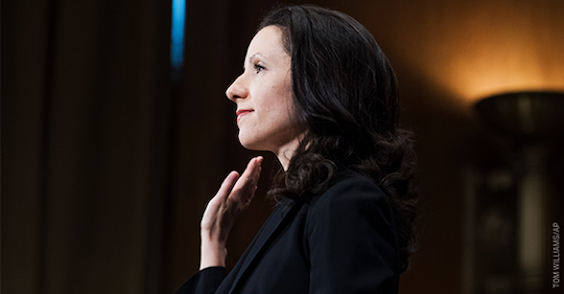[Fair Courts]

Federal Judicial Nominations
Youngest Federal Judge in Over 15 Years Confirmed Despite Ties to SPLC-Designated “Hate Group”
This week, Allison Jones Rushing was confirmed for a lifetime position to the Fourth Circuit Court of Appeals by a party-line vote of 53–44. At 37 years old, Rushing is the youngest federal judge confirmed in more than 15 years. As of 2017, the average age at the time of appointment to the bench of active circuit court judges was 50.6. Rushing’s nomination garnered significant opposition from civil rights groups because of her ties to the Alliance Defending Freedom, a conservative Christian legal organization classified by the Southern Poverty Law Center as an anti-LGBT “hate group” because of its efforts to ban same-sex marriage and recriminalize homosexuality domestically and abroad.
Several of Trump’s federal judicial nominees have been notably young. This week alone, the Senate confirmed two other young circuit court nominees, Eric Murphy (40 years old) and Chad Readler (46 years old). Trump’s nominees have also been notable for their lack of diversity.
Trump’s nominees have also significantly reshaped the federal bench. As a result of Senate Majority Leader Mitch McConnell’s (R-KY) prioritization of judicial confirmations, Trump has confirmed more circuit court judges than any other president at this point in his first term. According to Politico, Trump is on track to appoint “roughly 20 percent of the Circuit Court seats in the country after just two years in office.”
Federal Judicial Nominee Confirmed Without Blue Slip from Either Home-State Senator
The use of “blue slips” has changed over time. First adopted in 1917, blue slips worked to ensure the White House consulted with senators on judicial nominations in their state.
From 2007 to 2017, both home-state senators were required to return blue slips for a judicial nominee to be considered by the Senate Judiciary Committee. But Chuck Grassley (R-IA), the former Chairman of the Senate Judiciary Committee, changed this policy in 2017. Since then, several circuit court nominees have been confirmed while lacking one affirmative blue slip from a home-state senator.
Last week, Eric Miller was confirmed by Senate Republicans to the Ninth Circuit Court of Appeals. According to The Hill, “Miller is the first circuit court nominee to be confirmed without a blue slip from either home-state senator.” Speaking from the Senate floor, Sen. Patty Murray (D-WA) warned Miller’s confirmation marked “a massive departure from the long-standing bipartisan process that has been in place for generations.”
Senate Majority Leader Mitch McConnell (R-KY) has also indicated that he may use the “nuclear option” to “shave debate time from 30 hours to just two hours” for circuit and district court judges, allowing for “much quicker confirmation of lower court judges.”
State Courts
Arizona Supreme Court Vacancy Shines Light on Lack of Judicial Diversity
People of color comprise about 44 percent of Arizona’s general population, but only 14 percent of its state supreme court (or one justice) is a person of color, according to the Arizona Republic. Historically, Arizona’s Supreme Court has failed to reflect the diversity of its general population: the state’s high court “existed for nearly five decades before a woman made it onto the bench,” and “[f]ifty-five more years passed before the first Latino justice arrived.”
As Arizona Governor Doug Ducey (R) prepares to fill two vacancies, the composition of the court “is under renewed scrutiny.” Diversity is an essential component of a fair and impartial judiciary; however, Ducey “has said he doesn’t focus on race, ethnicity or gender when considering candidates for judicial appointments.” The shortlist for the seat of retired Justice John Pelander includes a female candidate who “would be the first black and Latina justice on the court,” and a male candidate who “identifies as half-Latino.”
Arizona is not the only state whose high court fails to reflect the diversity of its overall population: in 2016, people of color comprised nearly 39 percent of the population but only 13 percent of state supreme court justices across the country. In all, 24 state supreme courts did not have a single justice of color in 2016.
Access To Justice
Lawsuit Challenges ICE’s Use of Video Teleconferencing for Removal Proceedings
Last year, Immigrations and Customs Enforcement’s (ICE) New York Field Office adopted the exclusive use of video teleconferencing (VTC) for removal hearings, whereby “detained immigrants would appear by video feed from the county jails at which they are detained.” A class-action lawsuit filed last month by Brooklyn Defender Services, the Legal Aid Society, and the Bronx Defenders claims that this VTC-only policy is “merely pretext” for “limiting due process, access to the courts, and counsel for immigrants in an effort to rush deportations and deport more people.”
ICE argues VTC provides an efficient solution to the backlog currently facing immigration courts. But the lawsuit alleges that efficiency “has come at the expense of due process,” as detained immigrants “who might otherwise be granted the ability to stay in the United States instead could be deported” due to difficulties communicating with their lawyer, immigration judge, and/or translator via video. The suit also argues that “technical failures have been rampant, preventing detained immigrants from seeing, hearing, or understanding what is happening in the courtroom,” which is compounded “when detained immigrants require foreign language interpretation services.”
The suit is currently pending in the United States District Court for the Southern District of New York.